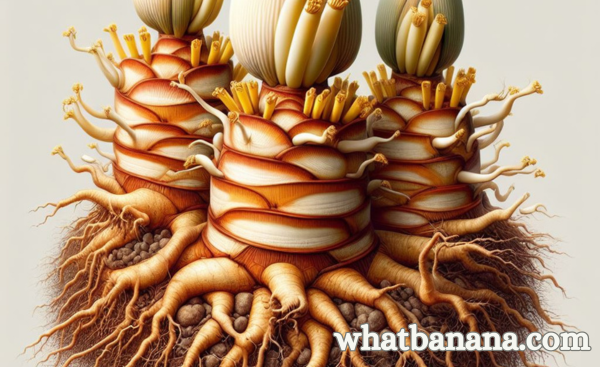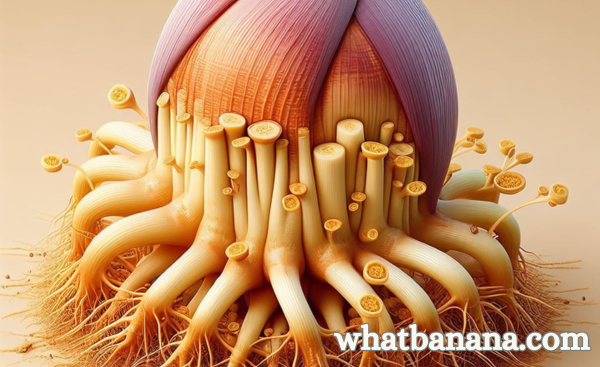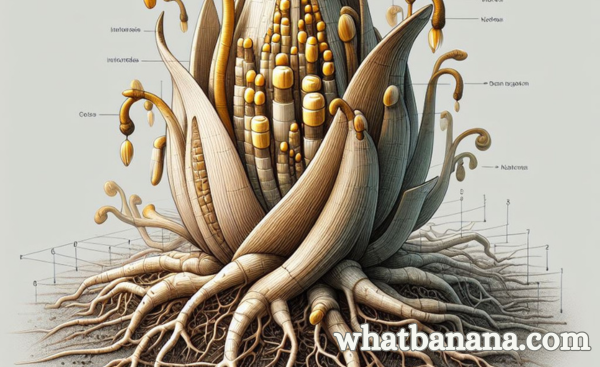Banana rhizome planting holds a pivotal role in the agricultural sector, particularly in the cultivation of one of the world’s most beloved fruits – the banana.
This method of planting is not just a mere agricultural practice; it’s a cornerstone in ensuring sustainability and food security globally.
Bananas, being a staple in diets across various cultures, demand effective and efficient cultivation methods to meet the ever-growing consumption needs.
Understanding the art and science of planting banana rhizomes is more than just agricultural knowledge.
It’s about embracing a method that contributes significantly to the ecological balance and the global food supply chain.
Banana Bonanza: Planting Rhizomes Like a Pro!
The process involves more than just planting a seed; it requires a deep understanding of the growth cycle of banana plants, starting from the rhizome, which is the heart of banana propagation.
In this comprehensive guide, we delve into every aspect of banana rhizome planting.
From the basic understanding of what a banana rhizome is, to the intricacies of planting, maintenance, and harvesting, this article aims to provide a thorough understanding of the entire process.
Our goal is to equip farmers, gardeners, and agricultural enthusiasts with the knowledge and skills needed to successfully cultivate bananas, ensuring a steady and sustainable supply of this essential fruit.
As we explore this topic, we emphasize not only the technical aspects but also the environmental and economic impacts of banana rhizome planting.
By the end of this guide, readers will have a holistic view of the importance, methods, and benefits of this crucial agricultural practice.

Understanding Banana Rhizomes
Banana rhizomes, often misunderstood as mere roots, are a critical component of the banana plant’s anatomy.
These underground stems are the foundation from which banana plants grow.
Unlike typical seeds or saplings used in various other forms of cultivation, banana rhizomes are unique in their growth process and the role they play in the propagation of banana plants.
To truly grasp the concept of banana rhizomes, one must understand their structure.
A rhizome consists of nodes and internodes; the nodes being the points from which the shoots (or the future banana plants) will emerge.
This characteristic allows for the vegetative propagation of bananas, ensuring that the new plants are genetically identical to their parent, thus maintaining the consistency in quality and characteristics of the bananas produced.
There are several types of banana rhizomes, each adapted to different growing conditions and climates.
Some are more resistant to drought, while others are better suited for wetter climates.
The diversity in rhizome types is a testament to the adaptability of the banana plant to various environmental conditions.
This adaptability is crucial for banana cultivation across different geographical regions.
It’s also worth noting the resilience of banana rhizomes.
They have the remarkable ability to survive under unfavorable conditions and can remain dormant until the conditions are right for growth.
This resilience is a boon for farmers in regions where weather conditions can be unpredictable and harsh.
Understanding the nature and types of banana rhizomes is essential for effective banana cultivation.
This knowledge helps farmers and gardeners make informed decisions about the selection of rhizomes, ensuring the best possible start for their banana plants.
The right choice of rhizome not only guarantees a good yield but also minimizes the risk of crop failure due to environmental stressors.
In summary, banana rhizomes are the cornerstone of banana cultivation.
Their unique growth process, diversity, and resilience make them an intriguing and vital aspect of banana agriculture.
A thorough understanding of banana rhizomes is, therefore, indispensable for anyone looking to delve into the world of banana farming.

Preparation for Planting
The journey to a bountiful banana harvest begins long before the planting of the first rhizome.
Preparation is key, and it involves several crucial steps that can significantly impact the success of the banana crop.
This preparation phase ensures that the plants have the best possible conditions for growth, leading to healthy and productive banana trees.
Selecting Quality Rhizomes
The first step in the preparation process is the selection of healthy and robust banana rhizomes.
The chosen rhizomes should be free from diseases and pests, as these can adversely affect growth and yield.
It’s essential to select rhizomes from high-yielding and disease-resistant banana plants.
The size of the rhizome also matters; typically, larger rhizomes with active buds are preferred, as they have a better chance of thriving.
Preparing the Soil
Soil preparation is another critical aspect of the planting process.
Bananas thrive in well-drained, fertile soil with a good organic matter content.
The soil pH should ideally be between 5.5 and 7.0.
Before planting, the soil should be tilled and enriched with organic compost or manure to improve fertility.
Proper soil preparation not only provides essential nutrients for the growing plants but also improves soil structure and drainage, which are crucial for banana plants.
Suitable Climate and Environment
Banana plants require a specific set of environmental conditions to flourish.
They grow best in warm, humid climates with consistent temperatures ranging from 26°C to 30°C (78°F to 86°F).
Areas with adequate sunlight are preferable, as bananas need full sun for optimal growth.
It’s also important to consider wind protection, as banana plants are susceptible to damage from strong winds.
If necessary, windbreaks or shelterbelts can be established to protect the young plants.
In conclusion, thorough preparation for banana rhizome planting is a fundamental step toward a successful banana crop.
It involves careful selection of rhizomes, meticulous soil preparation, and consideration of the environmental conditions.
By investing time and effort in this initial stage, farmers and gardeners can significantly improve the chances of a healthy and productive banana plantation.

Planting Process
The planting process of banana rhizomes is a meticulous task that sets the foundation for the growth and yield of the banana plants.
This phase is critical as it determines not only the initial establishment of the plants but also their long-term health and productivity.
To ensure the best start for the banana plants, the following steps should be carefully executed.
Preparing the Planting Site
Before the actual planting, the site must be prepared.
This involves clearing the land of weeds, debris, and other crops.
It’s important to ensure that the soil is well-tilled and loose to facilitate easy root penetration.
If planting in an area previously used for agriculture, it’s advisable to rotate the crops to prevent soil depletion and reduce the risk of disease carryover.
Digging Planting Holes
The next step is to dig holes for the rhizomes.
These holes should be about 30 cm deep and 45-60 cm in diameter, depending on the size of the rhizome.
The spacing between the holes is crucial and should be approximately 2-3 meters apart to provide enough space for the plants to grow without competing for nutrients and sunlight.
Planting the Rhizomes
When planting the rhizomes, care must be taken to ensure that they are placed correctly in the holes.
The rhizome should be placed upright with the bud facing upwards.
It’s important not to plant the rhizome too deep, as this can hinder the growth of the shoots.
After placing the rhizome in the hole, it should be covered with soil, leaving the top slightly exposed.

Initial Watering and Mulching
After planting, the rhizomes should be watered thoroughly.
This initial watering is crucial for establishing the rhizomes in their new environment.
Additionally, applying a layer of mulch around the planting area can help retain soil moisture, regulate soil temperature, and suppress weed growth.
Organic mulches like straw or dried leaves are preferred.
Care During the Early Growth Stage
In the weeks following planting, it is vital to monitor the plants closely.
This includes regular watering to keep the soil moist but not waterlogged.
Young banana plants are particularly susceptible to water stress, so consistent soil moisture is key to their survival and growth.
Additionally, any weeds that emerge around the plants should be removed to prevent competition for nutrients.
Use of Fertilizers
Fertilizers can be applied a few weeks after planting to provide additional nutrients to the young plants.
A balanced fertilizer, rich in nitrogen, potassium, and phosphorus, is recommended for banana plants.
It’s essential to follow the recommended dosage and application method to avoid over-fertilization, which can be harmful to the plants.
In conclusion, the planting process of banana rhizomes is a detailed and careful procedure that requires attention to various aspects such as site preparation, planting technique, and initial care.
By following these steps diligently, one can ensure a strong foundation for the healthy growth and eventual fruitful yield of the banana plants.

Maintenance and Care
After the banana rhizomes are planted, the focus shifts to maintenance and care, a critical phase in the lifecycle of banana plants.
Proper maintenance ensures healthy growth and maximizes fruit yield.
This stage involves several key practices.
Regular Watering
Banana plants have high water requirements, owing to their large leaf surface area.
Regular and sufficient watering is crucial, especially during the dry season.
The soil should be kept consistently moist but not waterlogged, as excess water can lead to root rot.
Drip irrigation systems are ideal for maintaining optimal soil moisture levels and conserving water.
Fertilization
Bananas are heavy feeders and require regular fertilization to sustain their rapid growth.
A balanced fertilizer, rich in nitrogen, phosphorus, and potassium, should be applied at regular intervals, typically every month.
The application should be carefully managed; over-fertilization can harm the plant, while under-fertilization can lead to poor growth and reduced yield.
Pest and Disease Management
Banana plants are susceptible to various pests and diseases, such as banana weevils, nematodes, and fungal infections like Black Sigatoka.
Regular monitoring and early detection are vital for effective management.
Biological control methods, along with cultural practices like removing infected plant parts, are preferred over chemical control to maintain an eco-friendly approach.
Pruning
Pruning involves removing dead or diseased leaves and redundant suckers (shoots emerging from the rhizome).
This practice helps in directing the plant’s energy to the growth of the main stem and the developing fruit.
Pruning also improves air circulation and sunlight penetration, reducing the risk of fungal diseases.
Supporting Banana Plants
As banana plants grow and their fruits develop, they become top-heavy and may require support to prevent them from toppling over.
Wooden stakes or other support systems can be used to keep the plants upright, especially in windy areas.

Soil Health Management
Maintaining soil health is crucial for the sustained productivity of banana plants.
Regular application of organic matter, like compost or manure, can improve soil structure and fertility.
Crop rotation and intercropping with legumes can also enhance soil health and reduce pest and disease incidence.
Mulching
Mulching is beneficial in conserving soil moisture, regulating soil temperature, and suppressing weed growth.
Organic mulches like straw, grass clippings, or dried leaves are preferred.
Mulch should be replenished regularly to maintain its effectiveness.
In conclusion, the maintenance and care of banana plants are multifaceted and require consistent attention.
By ensuring proper watering, fertilization, pest and disease management, pruning, plant support, soil health, and mulching, farmers and gardeners can foster robust growth and achieve high yields from their banana plants.

Harvesting and Post-Harvest Care
Harvesting bananas at the right time and providing appropriate post-harvest care is crucial for ensuring the quality and longevity of the fruit.
This stage requires precision and careful handling to maximize the produce’s market value and shelf life.
When to Harvest
Bananas are typically harvested while still green and firm.
The right time for harvesting is usually determined by the size and fullness of the fruit, rather than color.
A good indicator is the disappearance of angularity on the bananas, meaning they have been filled out.
Depending on the variety and climate, this can occur 75-180 days after the flower emergence.
Harvesting Technique
Harvesting involves cutting the entire bunch from the plant using a sharp knife or machete.
It’s essential to handle the bunches gently to avoid bruising the fruit.
Once cut, the bunches should be promptly transported to a processing area to prepare them for storage or sale.

Post-Harvest Handling
Post-harvest care includes removing the individual fruit clusters from the bunches and trimming the stems.
The bananas should be cleaned and inspected for any damage or disease.
Quick and efficient handling minimizes the time the fruit spends in the field, reducing the risk of spoilage.
Storage and Transportation
For storage, bananas are kept in a cool, shaded place.
If the intention is to ripen the fruit before sale, controlled ripening can be done using ethylene gas.
During transportation, the fruit should be cushioned and arranged to prevent damage.
In conclusion, proper harvesting and post-harvest handling are vital for maintaining the quality of bananas.
Timely and careful practices ensure the fruit reaches the consumer in the best possible condition, enhancing its value and reducing waste.

FAQ Section
Q1: What is the best time of year to plant banana rhizomes?
A1: The ideal time to plant banana rhizomes is at the beginning of the rainy season, as the consistent moisture helps establish the plants. However, in regions with controlled irrigation, planting can be done throughout the year.
Q2: How often should banana plants be watered?
A2: Banana plants require regular watering to maintain moist soil, typically once every 2-3 days. However, avoid over-watering to prevent root rot.
Q3: Can banana plants grow in any type of soil?
A3: Banana plants thrive in well-drained, fertile soil rich in organic matter. Soil pH between 5.5 and 7.0 is ideal.
Q4: How do I protect banana plants from pests and diseases?
A4: Regular monitoring, removing affected parts, and employing biological control methods are effective. Also, maintain good field hygiene and practice crop rotation.
Q5: When are bananas ready to harvest?
A5: Bananas are ready to harvest when they are full-sized, plump, and still green. Look for the disappearance of angular edges as a maturity indicator.
My Final Thoughts
In summary, successful banana rhizome planting and cultivation involve understanding the plant’s needs, meticulous preparation, and dedicated care.
By following these guidelines, growers can ensure a thriving crop, contributing to sustainable agriculture and fulfilling the demand for this essential and nutritious fruit.

thanks very interesting.